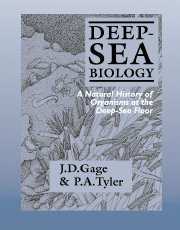Book contents
- Frontmatter
- Contents
- Preface
- Acknowledgements
- PART I The development of deep-sea biology, the physical environment and methods of study
- PART II Organisms of the deep-sea benthic boundary
- 4 The megafauna
- 5 Smaller animals
- PART III Patterns in space
- PART IV Processes: patterns in time
- PART V Parallel systems and anthropogenic effects
- References
- Species index
- Subject index
4 - The megafauna
Published online by Cambridge University Press: 05 June 2012
- Frontmatter
- Contents
- Preface
- Acknowledgements
- PART I The development of deep-sea biology, the physical environment and methods of study
- PART II Organisms of the deep-sea benthic boundary
- 4 The megafauna
- 5 Smaller animals
- PART III Patterns in space
- PART IV Processes: patterns in time
- PART V Parallel systems and anthropogenic effects
- References
- Species index
- Subject index
Summary
THE ERRANT MEGAFAUNA
The large, active forms may be termed errant megafauna as opposed to attached forms which make up the sessile megafauna. The errant megafauna include those forms that have been most easily caught in deep-sea trawls and dredges since the earliest exploratory work in the deep sea. Hence, these species, dominated by the phylum (a major division of the animal kingdom) Echinodermata (usually spiny-skinned animals that include sea urchins and starfish) and, to a lesser extent, decapod crustaceans of the phylum Arthropoda (which includes insects, spiders and crabs) and various bottom-living fishes, are the best known, and their taxonomy the best developed of the benthos and benthopelagic fauna of the deep sea. However, discovery of a scavenging community composed of previously virtually unknown, giant-sized crustaceans called amphi-pods, elsewhere of generally fly-like dimensions, has shown that it is unsafe to assume that most of this errant megafauna will be caught in bottom trawls.
ECHINODERMS: BRITTLE STARS AND BASKET STARS
Of the five large classes of modern echinoderms, the Ophiuroidea (brittle stars and basket stars), Asteroidea (sea stars), Echinoidea (sea urchins) and Holothurioidea (sea cucumbers), make up by far the most important of the errant epifauna. In a relatively well-known area of the deep sea such as the Rockall Trough, the brittle stars make up 27% of the echinoderm species collected, but numerically they far outnumber (63%) the remaining megafaunal catch.
- Type
- Chapter
- Information
- Deep-Sea BiologyA Natural History of Organisms at the Deep-Sea Floor, pp. 61 - 114Publisher: Cambridge University PressPrint publication year: 1991
- 1
- Cited by

